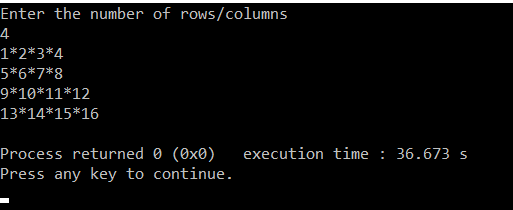Print Number Star Square Pattern Type1
PRINTING PATTERN:
1*2*3*4
5*6*7*8
9*10*11*12
13*14*15*16
PREREQUISITE:
Basic knowledge of C language and use of loops.
ALGORITHM:
- Take the number of rows/columns as input from the user and store it in any variable.(‘l‘ in this case).
- Run a loop ‘l’ number of times to iterate through each of the rows. From i=0 to i<l. The loop should be structured as for( i=0 ; i<l : i++).
- Inside this loop run another nested loop to iterate through the columns. From j=0 to j<l. The loop should be structured as for(j=0 ; j<l ; j++).
- increment count and the run an if condition if(j==l-1) .
- which means if it is the last column then print only count
- Else print a star after count
- outside the loop print a newline
CODE IN C:
#include<stdio.h>
int main()
{
int i,j,l,count=0; //declaring integers i,j for loops and l for number of rows
printf("Enter the number of rows/columns\n"); //Asking user for input
scanf("%d",&l); //Taking the input for number of rows
for(int i=0;i<l;i++) //Outer loop for number of rows
{
for(int j=0;j<l;j++) //Inner loop for number of columns in each row
{
count++; //incrementing count
if(j==l-1) //running if statement to not print star after the last column of digits
{
printf("%d",count); //printing count
}
else //else statement to print star after count
{
printf("%d*",count); //printing star after count
}
}
printf("\n"); //Printing a new line after each row has been printed.
}
}
TAKING INPUT:
DISPLAYING OUTPUT:

Login/Signup to comment



n=4
start1=1
for i in range(1,n+1):
num1=start1
for j in range(1,n+1):
print(num1,end=””)
if j<4:
print("*",end="")
num1+=1
print()
start1=start1+n
Python:
m=1
for i in range(4):
for j in range(4):
print(‘%d*’%m,end=”)
m+=1
print()